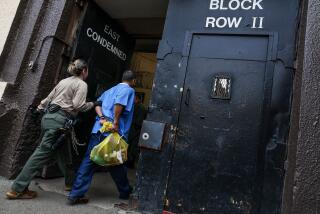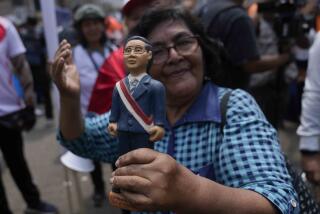260 Die in Peru Prison Revolts : Troops Crush Maoist Uprising at 3 Facilities
- Share via
LIMA, Peru — Peruvian marines Thursday stormed an island prison, quelling an uprising that killed at least 250 Maoist inmates, a member of the nation’s Cabinet told The Times. At least 10 troops were killed.
The final assault at El Fronton prison leveled a two-story concrete building in which a small band of the guerrillas had taken refuge, the minister said.
El Fronton, three miles off the coast, and two mainland prisons had been seized at dawn Wednesday in coordinated revolts by members of a Maoist guerrilla band called Sendero Luminoso (Shining Path).
The Cabinet minister said at least 100 prisoners died in an early morning attack by troops and police at Lurigancho prison in Lima.
By nightfall Thursday, at least 70 dead prisoners had been identified at El Fronton, with the final count at the three facilities expected to rise sharply to a total of around 250, the minister said after a Cabinet meeting with President Alan Garcia.
The minister, who asked not to be identified directly, said government casualties in a day of savage fighting included at least 10 dead, including a number of navy and marine officers.
“At El Fronton terrorists died singing, ‘The people will overcome,’ ” the minister said.
A government communique Thursday had reported 124 dead in Lurigancho and 30 at El Fronton with “an unknown number trapped or buried in tunnels, at least one of which led to the sea.”
Two inmates died and four others were wounded in an assault by police on a third facility, called Santa Barbara, which houses about 60 women guerrillas in a converted house in Callao, Lima’s port city. A government statement announcing Santa Barbara’s recapture said that inmates used weapons and high explosives to combat police.
Three hostages, including the warden of the women’s jail, were rescued, the government said.
Completely Destroyed
At El Fronton Thursday, repeated attacks by the Peruvian armed forces leveled the island prison’s 50-by-20-yard building occupied by the terrorists. Government television film, aired late Thursday to the musical accompaniment of Antonin Dvorak’s “New World Symphony,” showed the structure completely destroyed.
The minister said Garcia had ordered the military assault Wednesday night with unanimous support from his Cabinet after efforts by a government-appointed peace commission were rebuffed by the rebels.
Of nine reported hostages held by the guerrillas, at least five and perhaps as many as eight were known to have survived.
Unacceptable Demands
“On Garcia’s instructions, the peace commission asked the subversives to release their hostages and lay down their arms. They replied with a list of 26 unacceptable demands,” the Cabinet minister said.
Troops storming the guerrilla strongholds (at Lurigancho and El Fronton) encountered concrete walls built by the guerrillas as defensive redoubts with government-donated cement, the minister said, confirming government communiques.
Homemade Weapons
The prisoners, armed with a handful of seized weapons, smuggled dynamite and homemade weapons that included slingshots and crossbows, had constructed booby traps to delay the entry of attacking troops.
As resistance continued at El Fronton on Thursday afternoon, Peruvian Atty. Gen. Cesar Elijalde went to El Fronton in what the government said was an attempt to prevent further loss of life. But amid the smoke from the ruins, an obviously moved Elijalde told a government film crew, “These fanatics had a law, they had a constitution. They preferred terrorism. They invited this bloodbath.”
Humiliation Sought
The Peruvian government charged that the simultaneous uprisings at the three prisons was an attempt to humiliate Garcia’s administration as delegates arrive for the first conference the Socialist International has held outside Europe. The 37-year-old Garcia’s party, the American Popular Revolutionary Alliance, is allied with the International, a grouping of Socialist and Social Democratic parties. Garcia is to inaugurate the meeting with a speech today.
The worst violence came at El Fronton, at a building called the Blue Pavilion, which the guerrillas had been allowed to administer themselves. Guards did not normally enter the building, whose walls the Maoists decorated with revolutionary slogans to complement a defiant hammer and sickle they painted on an adjacent water tower.
When Peruvian marines made their first assault on the concrete building Wednesday night, there were thought to be about 160 Sendero Luminoso members inside with four hostages. As fighting continued Thursday, there were unconfirmed reports that at least 50 people had died in Wednesday night’s initial attacks.
The armed forces, responsible for security in metropolitan Lima under a four-month-old state of emergency provoked by earlier guerrilla attacks, reported “a large number of dead” in the retaking early Thursday of Lurigancho penitentiary on the mainland here, Peru’s largest prison.
At least 13 members of the armed forces were wounded, five seriously, in the five-hour assault on Lurigancho, a communique from the joint chiefs of staff said. About 250 guerrillas were among about 5,500 prisoners at Lurigancho when the assault began around 1 a.m., the curfew hour for this nervous capital of 6 million.
The government said the attack ended at 6 a.m., but the prison was still sealed, even to Peruvian government judicial and medical officials, many hours later.
Other Fighting
In a separate communique Thursday, the armed forces reported the deaths of 22 Sendero guerrillas in three Wednesday encounters in the Andes Mountains. Army patrols killed 19 guerrillas in two skirmishes near the city of Ayacucho, birthplace of Sendero Luminoso, and police killed three others after they dynamited a bridge in Puno province farther south, the report said.
The Sendero Luminoso rebellion has claimed an estimated 10,000 lives in Peru since 1980. It is led by former university professor Abimael Guzman, who calls himself the world’s only true Marxist since the death of China’s Communist Party Chairman Mao Tse-tung.
Sendero Luminoso is marked by extreme zealotry and discipline. Conceived and directed by middle-class intellectuals at the head of peasant soldiers, it reviles more traditional Peruvian Marxists, who are Garcia’s largest opposition in congress.
Alarm from Sendero’s early and unsophisticated attacks in mountain hamlets was slow to filter to coastal Lima, but with police on the defensive in 1983, then-President Fernando Belaunde Terry called in the armed forces to fight the Maoists. The army won back the countryside at the expense of a sharp increase in alleged human rights abuses, but rebels became increasingly active here in the capital, where about a third of Peru’s 20 million people live.
Security Measures
After a series of Andean jailbreaks, the Belaunde government decided to cluster Sendero prisoners in Lima jails for better security. They first went to little used El Fronton, long Peru’s maximum security prison, and then, as their number increased, to sprawling Lurigancho.
At El Fronton, the guerrillas were left to police themselves in the Blue Pavilion, which has bars on the windows but large inside rooms instead of cells. They cooked their own food, ran their own classes in political education and administered their own discipline. Authorities made cement available for the prisoners to carry out repairs, and at least some of that material was used to build fortifications, the government’s communiques made plain Thursday.
At Lurigancho, Sendero prisoners were first housed in a similar self-administered building called the British Pavilion. After police used dynamite to quell an uprising that claimed 29 lives there last October, the guerrillas were moved to Lurigancho’s so-called Industrial Pavilion, which had housed carpentry and metal shops and the prison’s laundry. Guards did not enter the Industrial Pavilion.
Guerrillas presumably used the tools there to make arms and fortifications. When troops broke into the prison early Thursday they found “walls built behind walls,” one Peruvian source said.
More to Read
Sign up for Essential California
The most important California stories and recommendations in your inbox every morning.
You may occasionally receive promotional content from the Los Angeles Times.













